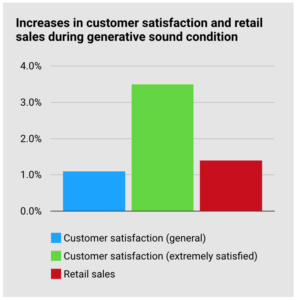Customer experience is a top priority for brands. One retailer wanted to understand how its in-store music was affecting customer experience – and find out if there was a better solution. It discovered that swapping its playlists for an ambient soundscape raised customer satisfaction and sales.
October, 2019
The in-store customer experience
 The way we shop has changed dramatically in recent years. Online retail changed the landscape of the market and, for a while, it looked like it was curtains for bricks and mortar stores. But recent trends show a resurgence in physical stores. They’re calling it the “clicks to bricks” revolution.
The way we shop has changed dramatically in recent years. Online retail changed the landscape of the market and, for a while, it looked like it was curtains for bricks and mortar stores. But recent trends show a resurgence in physical stores. They’re calling it the “clicks to bricks” revolution.
It turns out, e-commerce simply can’t replicate the experience of shopping in-store. So while customer experience is a top priority for all brands at the moment, for retailers it’s make or break.
Retailers understand the importance of customer experience. The problem is, most of them aren’t delivering. Consumers and brands themselves think there’s a shortfall in expectations versus reality when it comes to CX. But retailers can’t keep making the mistakes of old. They must look for innovative, customer-centric solutions.
A sound solution
One multinational retailer – a furniture warehouse – wanted to explore whether changing its approach to sound could be part of the answer. Its content consisted of background music playlists, interspersed with brand advertisements. Music is a valuable tool for brands, but it’s not right for every retail space. Playlists often sound similar from brand-to-brand and customer reactions can be unpredictable. So how would this “traditional” approach to sound compare to a more experience-led solution?
Generative sound
The retailer was particularly interested in the benefits of generative sound. Musician Brian Eno first coined the term generative sound. It describes sound that’s created by scripted rules and algorithms and therefore never repeats. The result is a constant stream of organic, fresh sound.
Eno has used generative sound in his art for many years, but it’s only recently that this technology has become available to retailers. In 2008, The Sound Agency developed the world’s first commercial generative sound player, which is now in its 9th development.
Generative sound can be favoured by retailers for a number of reasons:
1. It’s productive. Unlike music, it’s designed to sit in the background. It doesn’t irritate or call for attention. Instead, it creates a seamless, positive shopping experience.
2. It’s flexible and reactive. Generative sound can react live to external data, like the store’s noise levels or the outside weather.
3. It’s branded and ownable. Generative sound is custom-composed for a brand.
The results

The retailer carried out a 10-week trial, playing the different content on alternate days. They didn’t have custom generative sound yet, so instead played “off the shelf” content provided by The Sound Agency.
The results showed that customer satisfaction was 1.1% higher when the soundscape was playing, compared to the tailored music and ads. There was a 3.5% increase in extremely satisfied customers, and the retailer received significant positive verbal feedback from staff and customers. There was even a knock-on commercial effect: sales went up 1.4% when the generative sound was playing.
Of course, playing “off the shelf” content is a limited test of the technology. Other research shows that generative sound can bring even more remarkable customer experience benefits.
• Helm Bank used custom generative sound in their branches as part of a multi-sensory initiative. Customer satisfaction increased by 20%.
• Majid Al Futtaim used custom generative sound to boost happiness and energy levels in their malls by 8% and 9%, respectively.
• Napier University tested generative sound against pop music playlists. They found that generative listeners became more positive, clear-minded, and relaxed.
The first steps to better sound
These results represent just one of dozens of studies that show the tangible CX benefits of customer-centric sound. In reality, though, this approach tends to be the exception. Retail sound continues to be a hindrance. So, here are our recommended first steps to overcome those hurdles and improve your in-store experience.
1. Build awareness and understanding of sound.
Brands can only benefit from sound if their teams properly understand its impact. The Sound Agency’s BrandSound workshops are specifically designed for this purpose.
2. Avoid cookie-cutter solutions.
There’s no one size fits all when it comes to retail sound. Commission a sound audit to understand how your spaces are performing. It’ll help you develop more differentiated, customer-centric content.
3. Engage a specialist.
Sound in spaces is complicated and overhauling them can be a daunting undertaking. Engage a specialist with a holistic understanding of sound.
The Sound Agency creates branded, differentiated sound assets and experiences. If you’re interested in exploring how sound can improve your customer experience, please get in touch.